|
|
|
Road Test 1 |
|
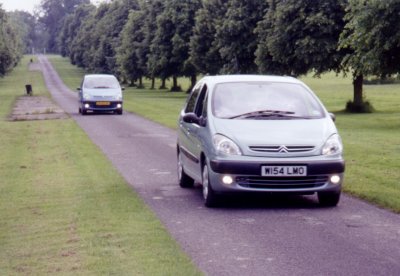
|
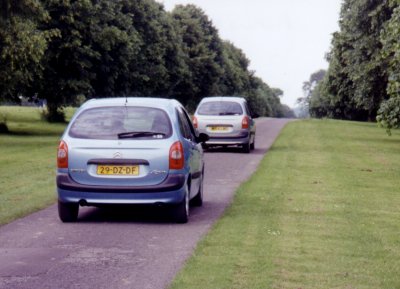
|
|
The
Xsara Picasso went on sale in the UK on 1st June 2000, some six months
after the rest of Europe. On 2nd June I went to Slough to pick up the
car that is the subject of this test, a mint green 1.8i SX.
Coincidentally we have been playing host once again to Arthur and Ellen Fryling from
the Netherlands who arrived in a blue HDi Picasso instead of their
normal XM CT Turbo
. At Slough we were told that there are a number of equipment
differences between vehicles intended for different markets but these
seemed to be confined to carpets in the Dutch car (an accessory), arm
rests in the UK car and an SX badge at the rear of the British car -
all important in establishing the hierarchy in the company car car
park. Strangely the Picasso badge only appears on the front flanks; at
the rear it is badged Citroën Xsara. The front fog lamps fitted as
standard to the UK car are also an accessory in the Netherlands.
|
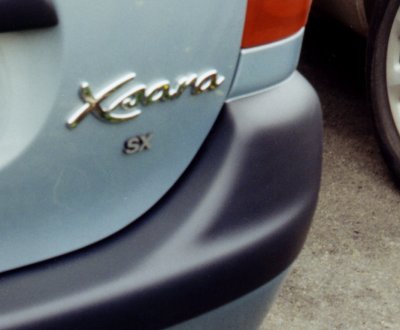
|
|
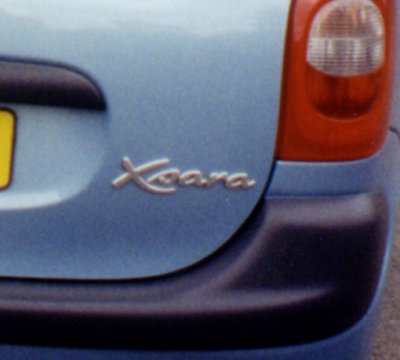
|
First
impressions were very good - an inspection of the bodywork in Citroën
UK's car park revealed no flaws at all. An inspection of the interior
revealed five full size seats that looked very comfortable indeed. A
huge boot (bigger, at 550 litres than that of a Xantia saloon) with
luggage hooks and an ingenious but probably not very robust folding
shopping trolley (called a Citroën Modubox ®), stowage spaces under the
rear floor just aft of the front seats, door pockets capable of
carrying a one and a half litre bottle, a large glove box and
additional storage areas showed careful attention to the needs of the
occupants. The boot can be extended to an astonishing 2000 litres with
the seats folded flat. A width of 1.16 metres between wheel arches
means that a pushchair can fit across the car rather than diagonally.
|
|
While
inspecting the boot, I cracked my head on the tailgate catch. As I
exercised my Anglo Saxon vocabulary, Arthur pointed out that the
tailgate has two open positions; a low one for the vertically
challenged and in car parks or garages with limited headroom and a high
one for lofty Anglo Saxons.
|
|
Climbing
(the verb is appropriate since one ascends into the vehicle)) behind
the wheel revealed a commanding driving position and Xantia/Xsara
switchgear and steering wheel although for some reason, the volume
control has been moved to the left as it has in the Xsara saloon and
coupé. With the seat adjusted so that the pedals and wheel were within
reach, I discovered that the parking brake is a long stretch down. My
wife, Christina who is shorter than I and with shorter arms found it
even more of a stretch.
|
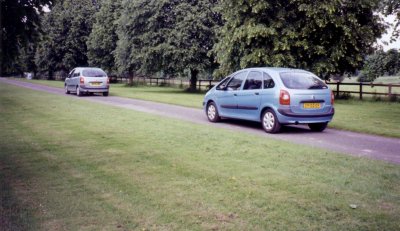
|
|
|
Turning
the key in the ignition brought the electronic instrument panel to
life. The instruments are located in the middle of the dash with the
digital speedo offset to the left - just as it is in the LHD car. In
the RHD car, checking your speed requires a deliberate eye movement
away from the road - perhaps this is why the "overspeed warning" is
fitted. This is an audible warning that sounds if you exceed a pre-set
speed as I discovered when I accidentally set the speed at zero mph and
thought my mobile 'phone was ringing as I moved away from some traffic
lights. I do not like digital displays for engine or road speed. They
do not indicate trends very well; determining whether there is an
increase or decrease in speed requires you to observe the instrument
for a few seconds and the Picasso?s speedo (there is no tacho) jumps by
2 mph increments. Furthermore, a conventional analogue instrument is
far easier to read - one retains a mental image of the instrument and
its calibrations and one need only look at the position of the needle
in relation to the mental image, one does not have to read the
calibrations. On the plus side, the display can be switched between mph
and kph (and concomitantly between mpg and litres per 100 km). Another
problem with the instrument panel is the sheer quantity of information
displayed - road speed, status of the central locking system, child
locks, date, time, exterior temperature, radio station or CD track,
miles remaining until the next service, average and instantaneous fuel
consumption, average speed, distance remaining before you need to
refuel, total and trip odometers, fuel gauge, etc. although to be fair,
not all this information is displayed simultaneously and the display,
with the exception of the speedo, can be switched off when your lights
are on. The language in which the information is displayed can also be
altered.
|
|
The
dash mounted gearchange falls readily to hand and gripping the part of
the lever that is concealed by the leatheroid gaiter reveals an
umbrella-shaped handle that would appear to have been inspired by the
2CV gear lever. The shift on my car was a little stiff but Arthur's car
was fine which would suggest that it will improve after a while. Pedals
were nicely weighted and there is a footrest for the left foot that is
perfectly positioned. The steering wheel is smaller than that fitted to
the Xantia and the steering (with variable assistance) is ideally
weighted while the steering itself is precise and informative. On both
cars, what I thought was the electro-hydraulic pump was audible but I
have been told that the steering is not electro-hydraulic and what I
was hearing was pump that pumps air into the exhaust system in order to
further reduce emissions.
|
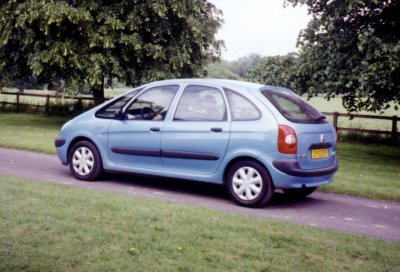
|
|
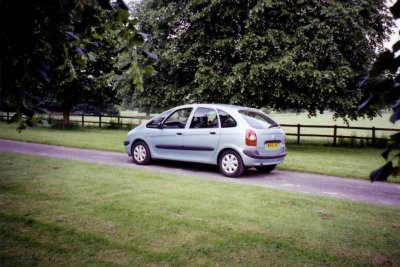
|
In
traffic, the commanding driving position gives one a feeling of
authority. Visibility is good apart from the three-quarters view to the
right where the thick screen pillars create a blind spot. On the M4
heading towards Newbury, there was sufficient power not to feel
embarrassed by forays into the overtaking lane. Even when extended in
the gears, the engine was quiet and smooth. Citroën's new lightweight
1.8i 16V petrol engine offers excellent refinement and driveability and
compared with its predecessor offers better fuel economy and lower
emissions while also being quieter - so quiet in fact that I thought it
had stalled when it was idling - noise vibration and harshness has been
reduced by 15%. This is the first application of this new engine and it
will undoubtedly find its way into other models over the next few
months.
|
|
With
a maximum power of 117 HP at 5500 rpm and maximum torque of 120 lb.ft
at 4,000rpm it can accelerate the car from 0-60 mph in about 10 seconds
and on to a top speed of 118 mph and yet it achieves as much as 36.7
mpg on the official fuel consumption combined cycle.
|
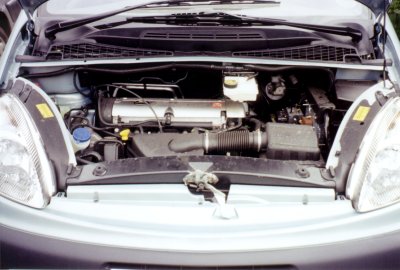 |
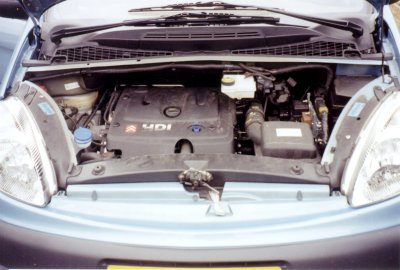 |
|
Gear
ratios matched the power characteristics of the engine and the good low
end torque allows it to be trundled along at 30 mph in top. Wind noise
was very low although opening any of the windows (electric at the
front, manual at the rear) resulted in buffeting and lots of noise.
Air-conditioning
was effective but noisy and, given my comments about the noise when the
windows are open, an essential rather than a luxury.
|
|
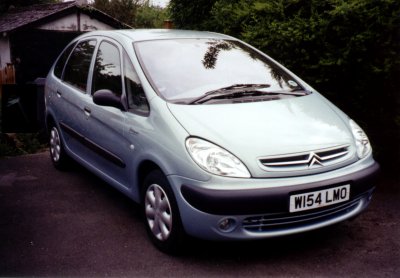
|
Off
the motorway, the Picasso revealed its Citroën heritage - pin sharp
handling (just like the Xsara saloon and coupé) and a good ride, albeit
not quite up to hydropneumatic standards. Body roll was very well
controlled and after a few miles, this inspires confidence which in
turn leads to higher cornering speeds than one might consider prudent
in such a tall vehicle. Yes, a compact MPV with hot hatch levels of
grip and handling! The ride is clearly better than the class norm with
mid-corner bumps being handled with equanimity. The seat damping, as
one has come to expect in a Citroën, was exemplary, with the seats
damping out those irregularities that manage to get past the suspension.
|
 |
© Julian Marsh 2000 |
|
|